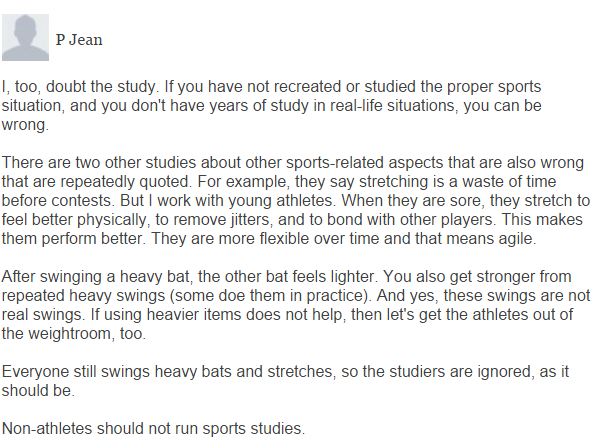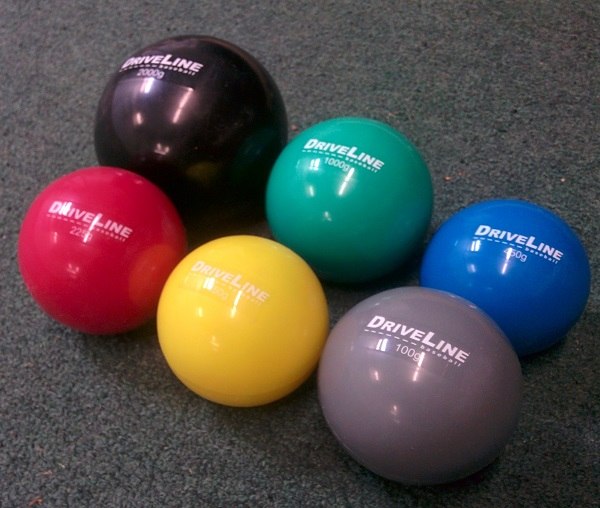Post-Activation Potentiation with Weighted Baseballs

Post-Activation Potentiation (PAP) is a controversial topic in exercise science, with research pointing in favor and against it working. PAP is not easy to describe, but the simplest way to put it is to think about testing your 60-yd dash time shortly after squatting 3-5 reps of heavy weight. The idea is that by “potentiating” the central nervous system (CNS) using heavy movements, performance increases in subsequent lighter and explosive movements.
Does it Work in Baseball?
First and foremost, it’s important to note that the most popular method of PAP in baseball does NOT work – using a donut or weighted bat sleeve in the on-deck circle before going up to hit.
Dr. Coop DeRenne, a legend in the world of baseball performance science, studied this very phenomenon years ago. Donuts used prior to swinging a real bat show a marked decrease in bat speed, yet hitters use them all the time. The reason for this isn’t because athletes are smarter or more experienced than sports scientists running controlled experiments, of course, it’s just a mix of inertia, superstition, and fear.
Or you could ask the scholarly people in the comments of major news sites, who have stunning results to share with us all:
The reason that PAP doesn’t work in the on-deck circle is because the use of the donut in an attempt to increase the bat weight makes no effort to grasp the significantly changed biomechanics of the swing by adding 200% or more of the weight to the bat in an uneven distribution. This makes the loaded donut swing a completely different motor pattern by drastically changing not only the mass of the bat, but the moment of inertia (MOI) of the bat as well.
In short, it doesn’t work. So if you use donuts in the on-deck circle (or at all, really), you should stop.
But What About Weighted Baseballs Prior to Pitching?
Ah, this is the million dollar question, isn’t it? What about throwing weighted baseballs prior to pitching to potentiate the CNS to increase output?
I think this is a rather fascinating concept, and as it so happens, we’ve studied this effect as best we can in the Driveline Sports Science lab. There are three generally-accepted methods of how PAP works, and the primary one we focused on was the idea that increased recruitment of higher order motor units would activate other motor units to allow for greater than average neuromuscular performance.
Study
Have athletes test run-and-gun velocities with a standard (5 oz) ball after a dynamic warm-up, then throw 6 oz and 7 oz overload balls for 3-5 reps each. After that, test run-and-gun velocities with the standard (5 oz) ball again and see if there are significant changes.
We also tested the OPPOSITE effect – we had athletes throw underload baseballs instead of overload to see if activation might work in a different manner.
Results
We split the athletes into two even groups as randomly as possible while controlling for age and skill level.
First we’ll discuss the underload group: It was a disaster. Subjectively the athletes overwhelmingly hated it when feedback was solicited, and objectively the data was clear as day – velocities went directly into the tank by 2+ standard deviations.
Some things said:
- “It feels like I’m throwing a brick”
- “I feel like I’m going to blow my elbow out”
- “I don’t want to throw 5 oz balls as hard as possible after that”
Pretty clear loser there. We moved underload balls back to where they’ve always been – at the end of the velocity run-and-gun tests.
The overload group, on the other hand, had mixed but statistically insignificant results. No athletes complained about the grouping of the weighted ball throws (5-6-7-5-4-3 oz) and while the average of the group saw higher velocities, it wasn’t statistically significant – and some lost velocity after throwing the overload baseballs. Some statistically insignificant trends that seemed worthy of future study were found, however:
- Professional pitchers are more likely to see the benefit of PAP with overload instruments
- Pitchers with certain types of arm action flaws were predisposed to realizing better velocities post-potentiation (and kinematics of the throw did change significantly)
- Amateur athletes who had trained under the Driveline system for some time saw little to no effect
So, What’s it All Mean?
Overall, I think the idea of PAP is very interesting and perhaps useful when it comes to weighted baseballs, but perhaps not prior to a game. Our study was a very limited trial that did not test one of the most important variables in a game – endurance.
It’s very possible that a comprehensive dynamic warm-up using proper tools captures enough of the “PAP” benefits, and athletes who do not warm-up and potentiate the CNS correctly prior to training or competing may see phantom benefits from what they think is truly PAP.
In that vein, however, we recommend all athletes use Plyo Ball ® to warm-up alongside their dynamic warm-up that should feature resistance bands, foam rollers, and other techniques to properly prepare the body and mind for competing on the diamond.
Comment section
Add a Comment
You must be logged in to post a comment.



Cromulent -
Yup, my son wanted to be like everyone else and use a donut. I didn’t let him.
But there was that one study that showed a significant positive effect for female softballers. Don’t know if it was ever replicated.
Cromulent -
I don’t get this:
“……idea of PAP is very interesting and perhaps useful when it comes to weighted baseballs, but perhaps not prior to a game.”
Then:
“we recommend all athletes use PlyoCare balls ….. to properly prepare the body and mind for competing on the diamond.”
Plyos are weighted balls too. I don’t get the distinction being made here.
drivelinekyle -
We split the distinction between PlyoCare balls and Driveline Elite Weighted Balls (which I refer to as “weighted balls”). Sorry for the confusion
Cromulent -
Which means you’ve tested plyos as an effective warmup for throwing from the bump. I saw your tweet pics showing them in your own adult league throwing. Will this be covered in the upcoming book? Did Beav pitchers do this last season?
drivelinekyle -
Yes, though my warm-up with PlyoCare balls is for a different reason. I have a partial thickness tear in my infraspinatus (and likely serious fraying in the supraspinatus), and I use them to activate my posterior shoulder. I’ll do upwards of 40-65 reps (split across 4-6 sets) of external rotation tosses into the air with the 1kg PlyoCare ball prior to picking up a baseball. Usually I do them after foam rolling, LAX ball rollouts, resistance band work, and arm oscillation work (I carry a Total Bar with me since it’s a little more portable than a Shoulder Tube).
It’ll be covered in the upcoming book for sure. Beaver pitchers did not use PlyoCare balls in warm-ups much, or at least it was not prescribed (some may have individually). This year may be different.
John Ryan -
Hi Kyle, in regards to what you posted, “weighted ball throws (5-6-7-5-4-3 oz)” is this also in the same order when you guys do regular velo work? Or was this just the order for the study?
Thank you
drivelinekyle -
Just for the study. This sequence also appears in our free weighted baseball eBook, available under “Our Books” in the top nav bar.
John Ryan -
I looked in the eBook. What page is it on because the order looks different?
Chez Angeloni -
Just as a side note… While training swings (not hitting or barrel accuracy, but swing patterns) I find it very useful when the athlete has an uncomfortably weighted bat to swing. I prefer just a heavy wood bat, but I get really good results from bat weights( the jack-it and donuts). The point is that that pattern needs to be strongly mapped and the athlete needs to have the wherewithal not to press the hands/arms to get the barrel into the zone. This ties into how weighted balls and plyo balls can rewrite inefficient patterns. At first, a poor thrower may push the heavier ball. Good coaching cues, dynamic actions with focus and intent can iron out the process and pattern quickly. With the swing, a heavy bat will help the athlete feel the depth of the barrel bottom out early in the turn in the proper pattern. Like the tendency for an inefficient thrower to push a heavier object at first, heavy bats will further ingrain a bad pressing pattern when left unattended. Also, the different placements of donut weights, jack-its etc can make this even harder to recognize as you described since sometimes more weight is felt closer to the hands. This is like anything else, any good drill can be woefully miscued or misconstrued by an athlete. Likewise, seemingly ridiculously drill work like throwing heavy balls hard in a pick-off stance can have truly breakthrough results with the right constraints being met. I like to test the “stickiness” of a pattern by seeing the athlete maintain his turn, barrel action depth and momentum transfer hold up to variable bat weights and balances.
GB -
What sorts of drills are used with the Plyocare balls? I’ve been looking everywhere and can only find a couple drills in your videos, was wondering if theres anywhere that you talk about drills, rep schemes, etc with them. Thanks
drivelinekyle -
That information is forthcoming in our flagship book and video set product, due out this offseason (December 1st, hopefully).
Mark Schmid -
Hi Kyle,
Back in 2013 Graeme Lehman posted an article on his site regarding a study, ” The acute and chronic effects of isometric contraction conditioning on baseball bat velocity” indicating that a simple on deck warm up routine that induced PAP with isometric contractions increased bat speed. The protocol involved hitters performing four reps of max effort isometric contraction for 5 seconds. A five second rest was allowed between repetitions. The first and third sets used the lead hand while the second and forth sets used the trail hand. They then rested for one minute and were then able to swing harder than before. As hitting and pitching have similar rotational qualities, do you have any thoughts on whether this might be beneficial for pitchers? Lehman was also considering a study for pitchers using the “Hershiser drill” as the isometric contraction, however, I haven’t seen anything from him on this. Curious to get your thoughts.
Is Weighted Baseball Long Toss Less Stressful on the Arm? - Driveline Baseball -
[…] This follows our standard regular-overload-regular-underload pattern that we’ve tested over the years. […]